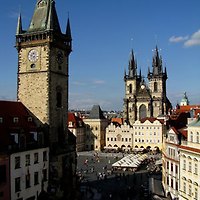Berlin is Germany’s largest and most multicultural city. More than 5 million people live in its metropolitan area and they hail from more than 190 nations. Berlin is a very dynamic, ever-changing and progressive city that continues to transform itself. No wonder it is the 3rd most visited place in Europe.
Throughout its tumultuous history, Berlin has transformed itself into one of the coolest destinations in Europe. Even President Kennedy was taken in with the spirit of this city when he said “Ich bin ein Berliner”. Berlin continues to leave its mark on many people from all over the world.

The city’s most renowned tourist attraction is, of course, the Berlin Wall. After the fall of Nazi Germany at the end of World War II, Berlin was divided into 4 sectors: the American, French and British sectors in the west, and the Russian sector in the eastern part of Berlin. During the course of the Cold War, tension increased between east and west, and residents of eastern Germany started to flee to the west. As a matter of fact, East Germany experienced a huge brain due to the mass emigration of skilled workers and professionals.
So in 1961 the East German government decided to build a barrier around West Berlin which effectively cut the city off from the surrounding areas in East German and East Berlin. The much-hated wall came down around midnight of November 9, 1989, after days of demonstrations. This peaceful revolution laid the groundwork for the reunification of Germany. Not much is left of the Berlin Wall today, but what is left is still fascinating.
The Reichstag is another one of Berlin’s top attractions. Built originally in 1894 as the parliament of the German Empire, it burned in 1933 and the fire was used by the incoming Nazis as an excuse to suspend most constitutional rights. After the fire it was mostly used as a backdrop for propaganda events and for military installations. Since the reunification of Germany, Berlin has become Germany’s capital again and the Reichstag once again became Germany’s parliament building.
Star architect Norman Foster won a competition for reconstructing the Reichstag which now features a giant glass dome that provides a gorgeous view over the city and into the parliament building below. The Reichstag is now the most visited attraction in Berlin.
Berlin museums cover a very diverse group of topics. The Museumsinsel (“Museum Island”) holds the Pergamon-Museum (ancient Greek and Middle Eastern / Islamic art), the Altes Museum (Egyptian art), the Alte Nationalgalerie (Old National Gallery – 19th century German paintings), the Neues Museum (New Museum – Egyptian, and prehistoric artifacts), and the Bode Museum (Byzantine Art).
Berlin’s turbulent history can be better understood by visiting the Jüdisches Museum (highlighting Jewish history in Germany), the Deutsches Historisches Museum, the Topography of Terror (located in excavated prison Nazi prison cells), the Mauermuseum at Checkpoint Charlie (commemorating the Berlin Wall and its most famous border-crossing checkpoint) and the DDR Museum (providing insight into life in the former German Democratic Republic).
The Story of Berlin is an interactive exhibition on the history of Berlin and features 23 theme rooms with animation and walk-through sets. It presents 800 years of Berlin history with a guided tour of an original nuclear bomb shelter.
Berlin has an excellent public transit system with subways (the U-Bahn Berlin), buses, trams and trains. A 7-day ticket will cost you between Euro 27.20 and Euro 60.00, depending on which areas of Berlin you want to cover. Make sure you validate your ticket to ensure you don’t get a Euro 40.00 fine.
Believe it or not, some Berlin hostels and budget accommodations may be had from 20 to 40 Euros a night, depending on the season. But don’t expect luxuries, and you’ll probably have to share your bathroom. Berlin hotels recorded almost 19 million overnight stays in 2009 and an estimated 135 visitors made day visits to Berlin. Business travel is also big contributor to tourism in Berlin: the city is among the top three convention destinations in the world.
One of the best ways for sightseeing in Berlin is to take a walking tour. There are many different tours out there with different themes, from traditional sightseeing to architectural to brewery and culinary tours as well as underground and alternative tours. Walking through the city with a local expert will give you a real insider’s perspective.
Berlin is a city with many parks and green spaces. Some of the most famous include the Tiergarten, the Schlossgarten Charlottenburg (inside Charlottenburg Palace) and Wannsee with its two lakes. The World’s Gardens is a collection of gardens from around the world with gardens from China, Korea, Bali and Japan.
Discovering Berlin by bike is another great way to see the city. As a relatively flat city, Berlin is a mecca for bicyclists. There are about 860 km of separate bike lines, and hundreds more of shared bike lanes. Locals love bicycling as well and use it as a major form of transportation. Bikes can be rented from about Euro 7.50 a day. Public bicycles provided by the German Railways are available in some locations as well.
Potsdam is definitely worth a day trip from Berlin. It was the residence of the Prussian Kings until 1918 and is Germany’s largest UNESCO World Heritage Site. Of particular interest are the palaces and surrounding parks of Sanssouci, the opulent former summer palace of King Frederick the Great.
Berlin is a fascinating destination year-round and it’s sure to captivate you'친절한 상담원, 백기가 ' 카테고리의 다른 글
| Eastern European Travel Discoveries with Michael Palin’s New Europe (0) | 2011.08.08 |
|---|
